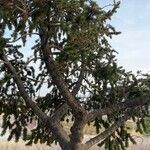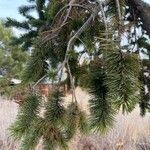A small soft pine. The bark is green and smooth but becomes reddish brown and cracked with age. The needles are in bundles of 5. They are 2-4 cm long. They remain on the tree for up to 20 years. They are curved and dark green. They are tufted towards the tip of the shoot. The seed cones are oval and 4-8 cm long. They are blunt tipped, greyish-brown and without stalks. The scales have a long slender prickle.



